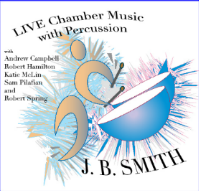J. B. Smith, Percussion Solo LIVE Chamber Music with Percussion
I’ve had the profound pleasure of collaborating with some extraordinary colleagues in the School of Music at Arizona State University. Recordings of several performances of chamber music presented on campus have been assembled for a Tresona Multimedia EP.
Track List
1. Alejandro Vinao: Tumblers (Katie McLin-violin)
2. Theresa Martin: Zero Infinity (Sam Pilafian-tuba)
3. Glenn Hackbarth: Passage (Robert Hamilton-piano)
4. Anthony Garcia: Soul'd Out (Sam Pilafian-tuba)
5. J. B. Smith: Coping Strategy I (Katie McLin-violin, Robert Spring-clarinet, Andrew Campbell-piano, Sam Pilfian-tuba)In Tumblers, a rhythmic phrase presented at the beginning of the piece is heard throughout in different forms, edited, repeated, shifted and multiplied like a cell of a growing structure. The players, like tumblers, unfold the shifting rhythms in the vertigo of a pulse which changes with every step. Tumblers was written for the marimba-violin duo Marimolin.
Zero and infinity represent powerful adversaries at either end of the realm of numbers that we use in modern science. Yet, zero and infinity are two sides of the same coin --equal and opposite, yin and yang...Zero Infinity is divided into three sections. Sections one and three are equals in that they both contain rhythmic drive. Second two, however, is the complete opposite of this, being very slow and lyrical. At times, the piece explores the extreme ranges of the tuba, many times stretching the technical limits of conventional tuba writing. The percussion part intensifies the rhythmic energy throughout the piece.
Passage is structured in two large sections separated by a minimal electronic interlude. The first section presents a toccata-like fabric in which thematic modules are juxtaposed in a manner loosely resembling a rondo. The second part gradually establishes a relaxed, floating ostinato over which thematic material from the first section reappears transformed in content and placed into continually changing contexts.
Anthony Paul Garcia, at the time a student composer at Arizona State, wrote Soul’d Out for Sam Pilafian and J. B. Smith in 2007. From the outset, an intricate rhythmic connection is made between the tuba and percussion instruments. Utilizing a large collection of instruments, the percussion part shifts continually from rhythmic, melodic and harmonic functions while the tuba traverses a sprawling landscape of colors and lines.
A group of five musicians can display characteristics resembling a single entity, a cross section of society or a chaotic amalgam of diverse creatures. In Coping Strategy I, activities ensue which can be described in all three modes: 1) A repeating seven bar chord progression, representing the life pulse of a single organism, is infected by a contrasting chromatic motive which eventually engulfs the chords. The infection is repelled, but returns to lead a dance of death, 2) Five individuals gradually interrupt a monotonous dialogue with disturbed interjections of dissonance, withdraw, then resume destruction of the monotony, 3) 5 instruments, all widely different in nature, choose idiomatic means to disrupt community of a musical status quo.
